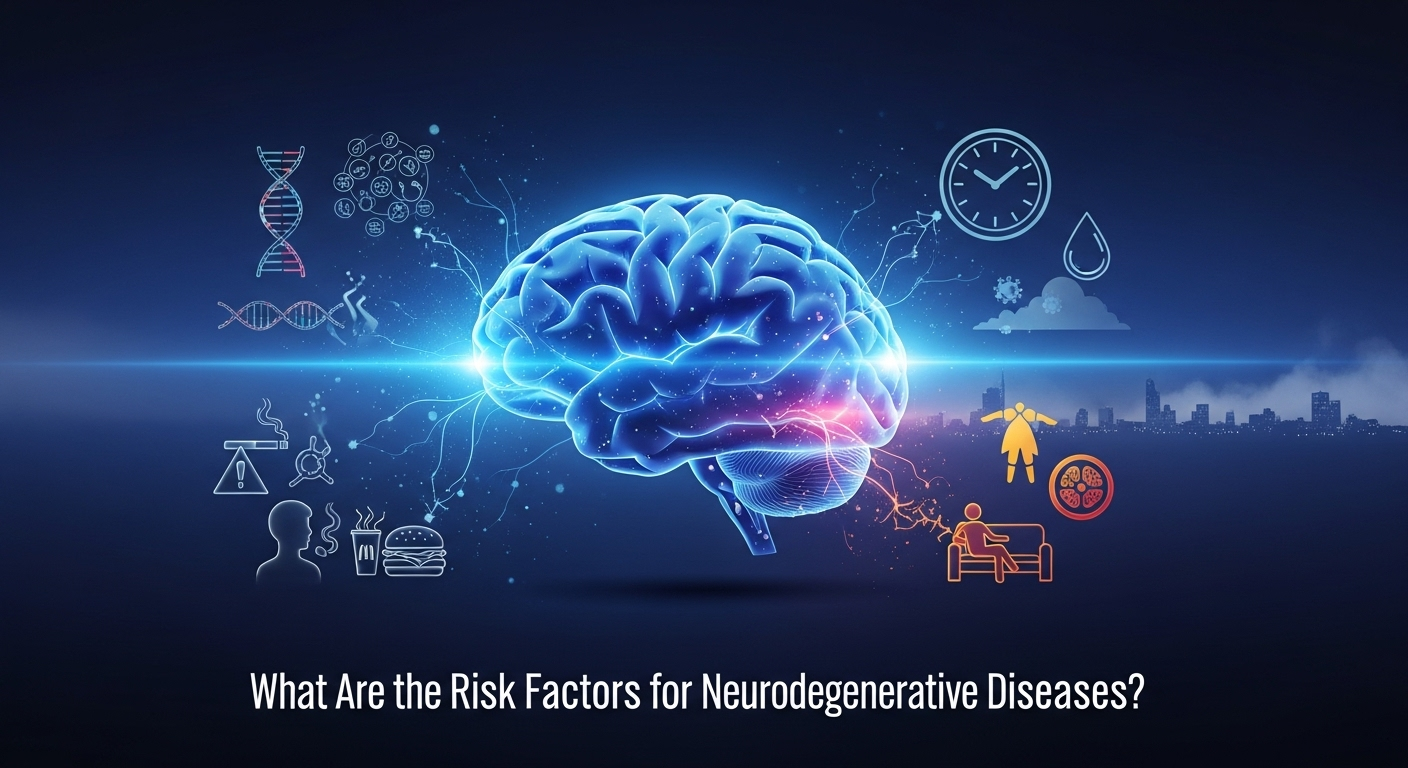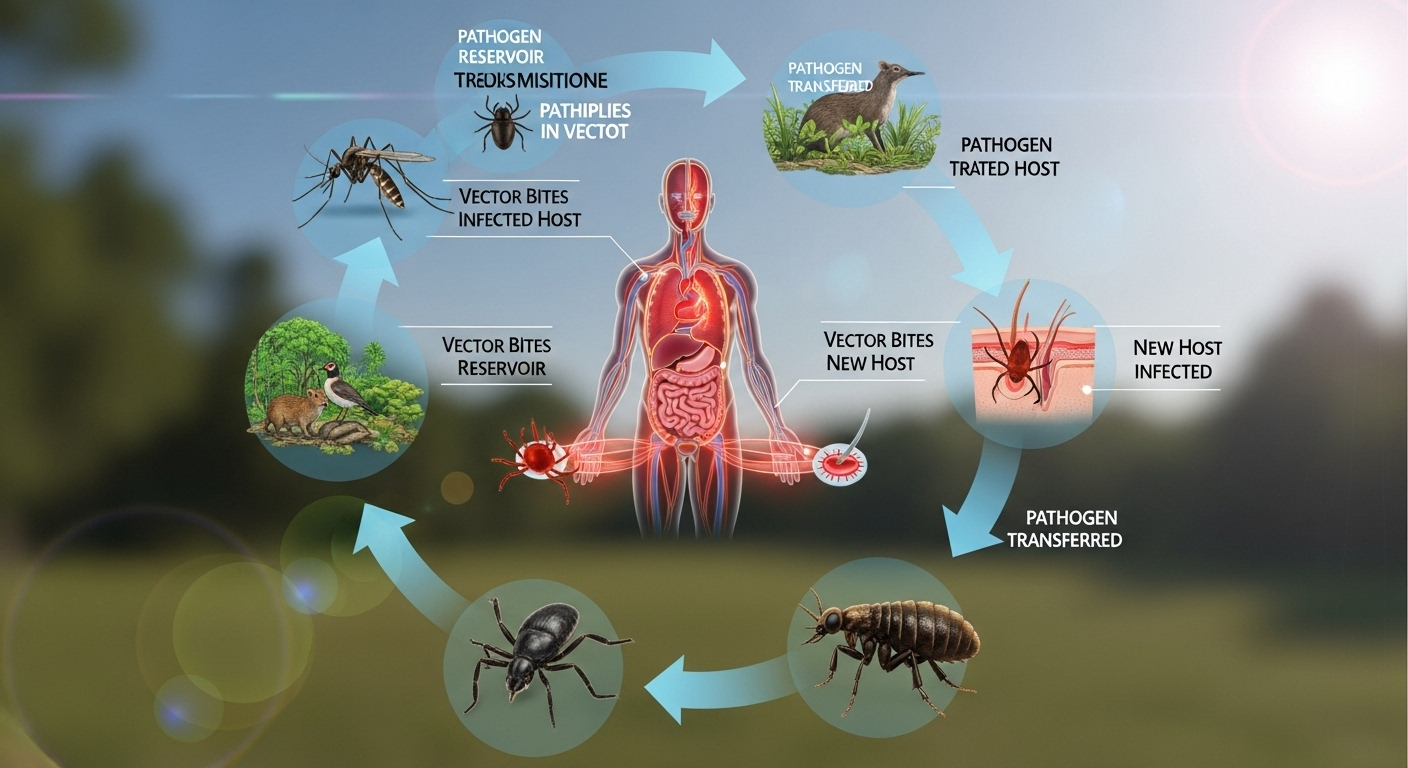Neurodegenerative diseases represent some of the most daunting challenges in modern medicine, stealthily eroding the very essence of who we are—our memories, our movements, and our cognitive abilities. Conditions like Alzheimer's, Parkinson's, and Amyotrophic Lateral Sclerosis (ALS) are characterized by the progressive loss of structure or function of neurons in the brain and spinal cord. While the exact causes of these diseases often remain elusive, a growing body of scientific research has illuminated a complex web of contributing factors. The journey to understanding these conditions begins with a clear-eyed look at the risk factors for developing neurodegenerative diseases, which span a spectrum from our genetic blueprint to our daily lifestyle choices. This knowledge is not just academic; it is empowering, offering pathways to potential risk reduction and a deeper appreciation for brain health.
Table of Contents
ToggleUnderstanding Neurodegenerative Diseases: A Foundation
Before delving into specific risk factors, it's crucial to understand what neurodegenerative diseases are and what they have in common. At their core, these conditions involve the gradual and irreversible death of nerve cells, or neurons. This loss of neurons leads to a decline in cognitive and/or motor functions. The specific symptoms a person experiences depend largely on which parts of the brain or nervous system are affected. For example, the death of dopamine-producing neurons in the substantia nigra of the brain leads to the characteristic motor symptoms of Parkinson's disease, while the accumulation of protein plaques and tangles in the cortex is the hallmark of Alzheimer's disease.
A common theme across many of these disorders is the misfolding and aggregation of proteins. In a healthy brain, proteins are folded into specific three-dimensional shapes to perform their functions correctly. In neurodegenerative diseases, certain proteins—such as amyloid-beta and tau in Alzheimer's, or alpha-synuclein in Parkinson's—misfold and clump together. These aggregates are often toxic to neurons, disrupting cellular processes, triggering inflammatory responses, and ultimately leading to cell death. This cascade of events unfolds over many years, often decades, before the first clinical symptoms become apparent.
This slow, progressive nature is what makes identifying risk factors so vital. By the time a diagnosis is made, significant and often irreversible neurological damage has already occurred. Therefore, the focus of much current research is on prevention and early intervention. Understanding who is at higher risk, and why, allows for the development of targeted strategies. These strategies can range from lifestyle modifications and environmental adjustments to potential future pharmacological interventions aimed at slowing or halting the disease process before it takes hold.
Unmodifiable Risk Factors: Genetics and Age
Some of the most significant risk factors for neurodegenerative diseases are those we cannot change: our age and our genetic makeup. These are considered "unmodifiable" because they are an inherent part of our biology. While we cannot alter them, understanding their role is fundamental to assessing personal risk and is a cornerstone of scientific research into the mechanisms of these diseases.
The Overwhelming Influence of Age
Age is, by far, the single greatest risk factor for most common neurodegenerative diseases, including Alzheimer's and Parkinson's. The incidence and prevalence of these conditions increase exponentially with advancing age. For instance, the risk of developing Alzheimer's disease doubles approximately every five years after the age of 65. This strong association is not a coincidence; the aging process itself makes the brain more vulnerable to the pathological changes that underlie these disorders.
Several age-related biological changes contribute to this increased vulnerability. These include a decline in the efficiency of cellular repair mechanisms, increased levels of oxidative stress and chronic low-grade inflammation (often termed "inflammaging"), and a reduced ability of the brain's waste clearance systems to remove toxic protein aggregates. Furthermore, decades of exposure to environmental toxins and the cumulative impact of lifestyle factors can take their toll. Essentially, the longer we live, the more opportunities there are for cellular machinery to falter and for damage to accumulate, creating a fertile ground for neurodegeneration to begin.
The Role of Genetic Predisposition
Genetics plays a crucial and complex role in determining an individual's risk. This role can be broken down into two main categories: rare, high-impact deterministic genes and common, low-impact risk-modifying genes. A very small percentage of cases, particularly for Alzheimer's and Parkinson's, are "familial" or hereditary, caused by mutations in specific genes that virtually guarantee the development of the disease, often at a much younger age. Examples include mutations in the APP, PSEN1, and PSEN2 genes for early-onset Alzheimer's.
More commonly, genetics confers a predisposition rather than a certainty. The most well-known genetic risk factor for late-onset Alzheimer's disease is the Apolipoprotein E (APOE) gene. We all inherit two copies of this gene, one from each parent, in one of three variants: ε2, ε3, or ε4. The ε4 variant significantly increases the risk and lowers the age of onset for Alzheimer's. Having one copy of APOE4 can increase risk two- to three-fold, while having two copies can increase risk by up to 12-fold. It is important to remember, however, that APOE4 is a risk factor, not a deterministic gene; many people with this variant never develop Alzheimer's, and many who have Alzheimer's do not carry the APOE4 variant.
Lifestyle and Modifiable Risk Factors: Taking Control
While we can't change our genes or stop the passage of time, a large and growing body of evidence shows that lifestyle choices have a profound impact on brain health. These "modifiable" risk factors are areas where individuals can take proactive steps to lower their risk of developing a neurodegenerative disease. The recurring theme is that what is good for the heart is also good for the brain.
The Critical Link to Cardiovascular Health
The brain is an incredibly metabolically active organ, consuming about 20% of the body's oxygen and glucose despite being only 2% of its weight. This requires a robust and healthy blood supply, delivered through a vast network of blood vessels. Consequently, any condition that damages the vascular system can also harm the brain. Midlife hypertension (high blood pressure), high cholesterol, and type 2 diabetes have all been strongly linked to an increased risk of dementia, particularly Alzheimer's disease, later in life.
These cardiovascular conditions can damage the small blood vessels in the brain, leading to reduced blood flow and contributing to what is known as "vascular dementia." More importantly, this vascular damage can also exacerbate the core pathologies of Alzheimer's disease. For example, poor blood flow can impair the clearance of toxic amyloid-beta proteins from the brain. Furthermore, conditions like diabetes, which involve insulin resistance, disrupt the brain's energy metabolism and promote inflammation, creating a hostile environment for neurons. Managing blood pressure, keeping cholesterol levels in check, and controlling blood sugar are therefore paramount for long-term brain health.
The Power of Diet and Nutrition
What you eat directly influences your brain's structure and function. Diets high in saturated fats, trans fats, and processed sugars are associated with poor cognitive outcomes and a higher risk of dementia. Conversely, dietary patterns that are rich in fruits, vegetables, whole grains, and healthy fats have been shown to be neuroprotective. Two diets, in particular, have received significant attention for their brain-boosting benefits: the Mediterranean diet and the MIND diet (Mediterranean-DASH Intervention for Neurodegenerative Delay).
These diets emphasize plant-based foods, fish, nuts, and olive oil, which are packed with antioxidants, anti-inflammatory compounds, and omega-3 fatty acids. Antioxidants help combat oxidative stress, a key driver of cellular aging and damage. Omega-3 fatty acids, particularly DHA, are a major structural component of brain cell membranes and are essential for neuronal signaling. Studies have shown that higher adherence to these diets is associated with better cognitive function, slower cognitive decline, and a significantly reduced risk of developing Alzheimer's disease.
The Necessity of Physical Activity
If there were a magic pill for brain health, it would be exercise. Regular physical activity is one of the most effective strategies for reducing the risk of neurodegenerative disease. Exercise benefits the brain through multiple mechanisms. It improves cardiovascular health, which in turn enhances blood flow to the brain, delivering more oxygen and nutrients. It also helps control body weight, blood pressure, and blood sugar, mitigating several key risk factors.

On a more direct-to-brain level, exercise has been shown to increase the production of a protein called Brain-Derived Neurotrophic Factor (BDNF). BDNF is like a fertilizer for neurons; it supports the survival of existing neurons, encourages the growth of new ones (neurogenesis), and promotes the formation of new connections (synapses). Furthermore, physical activity has potent anti-inflammatory effects and may even help stimulate the brain's waste clearance system to more effectively remove toxic protein aggregates. A combination of aerobic exercise, strength training, and balance work is recommended for optimal benefits.
Environmental Exposures and External Factors
Our environment, from the air we breathe to the physical forces we encounter, can also influence our risk of neurodegeneration. While the links are sometimes less definitive than for lifestyle factors, the evidence is compelling enough to warrant attention and caution. These external factors can introduce toxins or cause direct physical damage that accelerates the underlying disease processes.
Traumatic Brain Injury (TBI)
A history of head trauma, particularly moderate to severe Traumatic Brain Injury (TBI), is a well-established environmental risk factor for developing neurodegenerative diseases later in life. Even a single severe TBI can increase the risk of dementia, while repetitive mild TBIs—the kind often sustained in contact sports or military service—are strongly associated with a specific neurodegenerative condition called Chronic Traumatic Encephalopathy (CTE).
The immediate aftermath of a TBI involves widespread inflammation and neuronal death. In the long term, this initial injury can trigger a self-perpetuating cascade of pathological events, including the abnormal accumulation of tau protein in patterns similar to, yet distinct from, Alzheimer's disease. The injury can disrupt the blood-brain barrier, allowing harmful substances to enter the brain, and can permanently alter the brain's inflammatory response. Protecting the head by wearing helmets during sports, using seatbelts in vehicles, and preventing falls in older adults are critical preventative measures.
Exposure to Toxins and Pollutants
Research into the link between environmental toxins and neurodegenerative diseases is a complex and evolving field. However, several substances have been implicated as potential risk factors. Chronic exposure to certain pesticides and herbicides has been associated with an increased risk of Parkinson's disease. The mechanism is thought to involve the disruption of mitochondrial function—the energy-producing centers of the cell—and the promotion of oxidative stress, which disproportionately affects the vulnerable dopamine-producing neurons.
More recently, air pollution has emerged as a significant concern. Fine particulate matter (PM2.5) from traffic and industrial sources can be inhaled and may even travel directly to the brain via the olfactory nerve. These tiny particles can induce a strong inflammatory response in the brain, contribute to oxidative stress, and have been found in the amyloid plaques characteristic of Alzheimer's disease. While more research is needed to fully understand these connections, minimizing exposure to known neurotoxins and advocating for cleaner air are sensible public health goals.
A Comparative Overview of Common Neurodegenerative Diseases
To better contextualize the risk factors, it is helpful to see how they apply across different diseases. The following table provides a simplified comparison of three major neurodegenerative conditions.
| Feature | Alzheimer's Disease | Parkinson's Disease | Amyotrophic Lateral Sclerosis (ALS) |
|---|---|---|---|
| Primary Symptoms | Memory loss, cognitive decline, confusion, personality changes. | Tremor at rest, rigidity, slowness of movement (bradykinesia), postural instability. | Muscle weakness, twitching, atrophy, difficulty speaking, swallowing, and breathing. |
| Key Affected Area | Hippocampus and cerebral cortex (memory and thinking). | Substantia nigra (dopamine-producing neurons for movement). | Motor neurons in the brain and spinal cord. |
| Core Protein Pathology | Amyloid-beta plaques and Tau tangles. | Alpha-synuclein aggregates (Lewy bodies). | Aggregates of TDP-43 and other proteins. |
| Key Risk Factors | Age, APOE4 gene, cardiovascular disease, TBI, poor diet, low physical/mental activity. | Age, genetic factors (LRRK2, SNCA), male gender, pesticide exposure, TBI. | Age, male gender, genetic factors (~10% of cases are familial), smoking, military service. |
Frequently Asked Questions (FAQ)
Q: Can I completely prevent neurodegenerative diseases if I have a healthy lifestyle?
A: Unfortunately, there is no guaranteed way to prevent these diseases completely, especially since unmodifiable factors like age and genetics play such a strong role. However, adopting a brain-healthy lifestyle can significantly reduce your risk and delay the onset of symptoms. Think of it as stacking the odds in your favor. By managing cardiovascular health, eating a nutritious diet, staying physically active, and keeping your mind engaged, you are building a more resilient brain that is better equipped to withstand the challenges of aging.
Q: If one of my parents had Alzheimer's, does that mean I will get it too?
A: Not necessarily. While having a first-degree relative with Alzheimer's does increase your risk, it does not mean your diagnosis is inevitable. Most cases of Alzheimer's are "sporadic," meaning they are caused by a complex mix of genetic, environmental, and lifestyle factors, not by a single inherited gene. The rare, purely hereditary forms of the disease (familial Alzheimer's) typically have a very early onset (in one's 40s or 50s) and a clear family history across multiple generations. For most people, a family history is just one more reason to be proactive about managing modifiable risk factors.
Q: What is the single most important thing I can do to lower my risk?
A: While it's tempting to look for a single "magic bullet," research increasingly points to a holistic, multi-pronged approach as the most effective strategy. Instead of focusing on one thing, aim for synergy. However, if forced to choose one, many experts would point to regular physical activity. This is because exercise positively impacts nearly all other risk factors: it improves cardiovascular health, helps control blood sugar, reduces inflammation, lowers stress, and directly stimulates the production of brain-protective molecules like BDNF. Combining regular exercise with a brain-healthy diet and social engagement creates a powerful protective shield.
Conclusion
The landscape of risk factors for neurodegenerative diseases is intricate, blending the unchangeable realities of our genes and the passage of time with the empowering choices we make every day. While the influence of age and genetic predispositions like the APOE4 gene are undeniable, they do not write our destiny in stone. A wealth of scientific evidence powerfully demonstrates that we hold significant agency in shaping our brain's future.
By prioritizing cardiovascular health, engaging in regular physical activity, adopting a nutrient-rich diet like the Mediterranean or MIND diet, protecting our heads from injury, and staying cognitively and socially active, we can build a profound "cognitive reserve." This reserve acts as a buffer, enhancing the brain's resilience and potentially delaying or even mitigating the clinical expression of disease. The journey to better brain health is not about a single, perfect action, but about the consistent, cumulative effect of many positive choices. Understanding these risk factors is the first, most crucial step on that proactive path.
***
Summary
The article, "What Are the Risk Factors for Neurodegenerative Diseases?", provides a comprehensive overview of the factors that contribute to the development of conditions like Alzheimer's, Parkinson's, and ALS. It begins by explaining that these diseases involve the progressive death of neurons, often caused by the misfolding and aggregation of toxic proteins. The risk factors are broadly categorized into two groups.
First are the unmodifiable risk factors, which include age—the single greatest risk factor—and genetic predisposition, such as carrying the APOE4 gene for Alzheimer's. Second, and more a focus of the article, are the modifiable risk factors, over which individuals have considerable control. These include maintaining good cardiovascular health (managing blood pressure, cholesterol, and diabetes), adopting a brain-healthy diet (like the Mediterranean or MIND diet), engaging in regular physical activity to boost neuroprotective factors like BDNF, and pursuing cognitive and social engagement. The article also discusses environmental factors like Traumatic Brain Injury (TBI) and exposure to toxins and air pollution. A comparative table and an FAQ section clarify key differences between diseases and answer common questions. The central message is one of empowerment: while genetic and age-related risks cannot be changed, a proactive, holistic lifestyle can significantly lower one's overall risk and build a more resilient brain.














